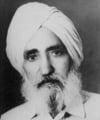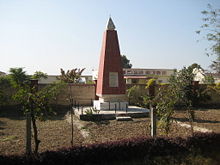Achhar Singh Chhina
| Achhar Singh Chhina | |
 Comrade Achhar Singh Chhina
| |
| Born | October 01 1899 Amritsar, Punjab, India |
|---|---|
| Died | March 21 1981 (aged 81) Amritsar, Punjab, India |
| Occupation | Politician |
Achhar Singh Chhina (1899-1981), was an Indian communist politician and independence activist. He served as a Communist Party of India MLA in the Punjab Legislative Assembly for two terms. In 1962 he contested Member Parliament (MP) election from Taran Taran and defeated by 1600 votes.
Early life
He was born at village Harsha Chhina, Tehsil Ajnala, Amritsar, Punjab, India. Achhar Singh Chhina done his basic studies from Khalsa College Amritsar where he played a pivotal role along with Pratap Singh Kairon former Chief Minister of Punjab. In 1920-1921, the students and teachers of the college registered their protest against the British rule by boycotting the visit of the Prince of Wales to the college.
In 1921 Comrade Chhina and Pratap Singh Kairon went to the USA for further studies. Both joined Berkeley University, Californiato do Masters in Economics. The same year he joined the Gadar Party in San Francisco and got his first lesson in national politics.
Political career
In 1932 he left America and went to the Soviet Union for further studies on socialism. He returned to India in 1936 and was arrested at Lahore in the same year, and was detained in Lahore Fort for two months.
Fatehwal Murder Case 1938-39
In 1937 British Government ordered Comrade Achhar Singh Chhina to live in his own village (curfew) for the whole year. In March 1938, on completion of his curfew period the communist party organised a conference at Fatehwal village Amritsar, to be headed by Comrade Achhar Singh Chhina and Mohan Singh Batth. However, in this conference due to the disturbance created by the police spies and attack on the stage leaders, two spies was killed by the conference attendees. Police registered a criminal Case against Comrade Achhar Singh Chhina and Joginder Singh Chhina along with other 47 persons under section 302 IPC. This case was highlighted throughout country and defense appointed a committee to fight a case. The committee was headed by Pandit Jawahar Lal Nehru and Dr. Saifud-din Kichlu. Police forced Mr. Ram Lal, a police constable, to give false statement in the court that at the time of murder Mr. Chhina was the main person who attacked the victim; however, he refused to give this statement in the court.[1]
Being involved in the Fathehwall Murder Case he had to go underground to escape the clutches of the police[2].
The case was defended by Advocate Dr. Saifud-din Kichlu along with other leading lawyers where judiciary founded Comrade Achhar Singh Chhina not guilty on all counts and sentenced Joginder Singh Chhina for 20 years against this Case.
Netaji and Comrade Chhina's first meeting at Calcutta
Subash Chandra Bose aka Netaji had first met Comrade Achhar Singh Chhina in April 1939 when he was visiting the Gaya district. At that time Chhina was hiding himself from the police as a result of the Fathewall Murder Case. Chhina sought Bose’s help and Bose advised him not to give himself up to the Police.
In early June 1940 Bose had shown his interest to Niranjan Singh Talib, a well-known freedom fighter to met Chhina. Achhar Singh Chhina visited Calcutta and met Netaji [3]. Bose expressed his desire to Comrade Chhina to go to the Soviet Union to meet Stalin. For this purpose Achhar Singh Chhina visited the Frontier Province to make arrangements for his escape to Russia. There he met Bhagat Ram Talwar who helped him to make arrangements for the stay of Netaji at Peshawar and from there for his escape to Kabul[4]. After making necessary arrangements he returned to Calcutta to bring Netaji to Peshawar, but Bose was arrested for taking part in Black Hole of Calcutta Movement in 1940 and consequently could not avail himself of the opportunity[5].
But Achhar Singh Chhina himself utilized the opportunity and went to the Soviet Union in 1940 by crossing the Hindukush Mountains on foot through Kabul and discussed the possibility of Independence with top Soviet Leaders[6].
Achhar Singh Chhina and International Politics
In 1942. The CPI was officially against the Quit India movement. Achhar Singh Chhina [known as ‘Larkin’ in Soviet Union] was actively involved in international politics. He worked closely with CPI to develop a directive of CPI, and carried that directive from the Soviet Union to India with the full knowledge of the British authorities.[7]
While crossing the Hindukush he was arrested by British government at Gilgit and was brought back to Lahore where he was locked up in Lahore Fort Cell. After staying for 4 months in Lahore Fort, he was transferred to the Campbell pore Jail from where he was released on 1st May 1942.
President of the Punjab Kisan Sabha
In 1942 he was elected as President of the All India Kisan Sabha - Punjab and held this position for seven years. It was in that capacity that he organized the Harsha Chhina Moga Morcha in 1946, as a result of which he was detained in Lahore jail for three months [8]. He also held a post of Secretary of the Punjab Communist Party.
Harsha Chhina Mogha Morcha 1946-47
In 1946, under the leadership of the Communist party 'Mogha Morcha of Harsha Chhina' was launched. Comrade Acchar Singh Chhina, Sohan Singh Josh, Purran Singh, Mohan Singh Batth, Jagbir singh Chhina, and Gurdial Singh Dhillon organised this Morcha against the ruling party, as a result of which Comrade Achhar Singh Chhina, Sohan Singh Josh and Gurdial Singh Dhillon was arrested along with 950 protestors and detained in Lahore jail for three months. [9] [10]
Due to this movement, all political parties negotiated with the ruling government to give farming water to the agriculturalists as per the agreement. [11] [12]
After Independence
In 1948 after India independence he went underground but was arrested in 1950 and detained in Ambala jail. While he was in jail, he was elected from Ajnala as a member of the Punjab Legislative Assembly (MLA) in 1952. In 1957 he was again elected from Ajnala as a member of the Punjab Legislative Assembly (MLA) and remained its member till 1962[13]. He was a founder of ‘Naveen Janta Public school’ which was taken over by the Punjab Government later and the name of the school was changed to “Comrade Achhar Singh Chhina Senior Secondary School.”
Positions held
1. President of the Kisan Sabha Punjab
2. Secretary of the Punjab Communist Party
3. Member Punjab Legislative Assembly - Ajnala (1952-1956)
4. Member of the Legislative assembly - Ajnala (1956-1962)
5. Member of the Ghadar Party Martyrs Memorial (Desh Bhagat Yaadgar), Punjab
6. Member Gadhar Party San Francisco (1922)
7. Founder of Naveen Vidhya Mandir, School
See also
Notes
- ↑ Fauja Singh, Chaman Lal Datta, Bakhshish Singh, Punjabi University Dept. of Punjab Historical Studies - Who's who: Punjab Freedom Fighters - Biography & Autobiography (1991), p. 342.
- ↑ Mihir Bose, Raj, Secrets, Revolution: A Life of Subhas Chandra Bose (India) (2004), p. 175.
- ↑ Fauja Singh, Eminent Freedom Fighters of Punjab(Punjab: India, 1972), p. 59.
- ↑ Bhagat Ram Talwar, The Talwars of Pathan Land and Subhas Chandra's Great Escape (India) (1976), p. 184.
- ↑ Sisir Kumar, Netaji and India's Freedom: Proceedings of the International Netaji Seminar (India) (1975), p. 153.
- ↑ Fauja Singh, Eminent Freedom Fighters of Punjab (Punjab: India, 1972), p. 60.
- ↑ Fauja Singh and Chaman Lal Datta, Who's who: Punjab Freedom Fighters (Punjab: India, 1991), p. 5.
- ↑ Mridula, Peasants in India's Non-Violent Revolution: Practice and Theory (2004), p. 227.
- ↑ S. Gajrani, Peasant Movement in Punjab, p. 33
- ↑ S. Gajrani, Peasant uprisings (1987), p. 120.
- ↑ Peasants in India's Non-violent Revolution: Practice and Theory, p. 567.
- ↑ Mridula Mukherjee, History (2004), p. 577.
- ↑ Hari Singh, Agrarian Scene in British Punjab(Punjab: India, 1984), p. 332.
ReferencesISBN links support NWE through referral fees
- Bose, Mihir. 1982. The lost hero: a biography of Subhas Bose. London: Quartet Books. ISBN 9780704323018.
- Chandra, Bipan. 1983. The Indian left: critical appraisals. New Delhi: Vikas. ISBN 9780706921038.
- Grover, Verinder. 1989. Political system in India. New Delhi: Deep & Deep Publications. ISBN 9788171001262.
- Guru Nanak Dev University. 1977. Punjab journal of politics. Amritsar: Dept. of Political Science, Guru Nanak Dev University. OCLC 5948389.
- Josh, Bhagwan. 1974. Communist movement in Punjab: (1926-47). Lahore: Book Traders. OCLC 85190394.
- Josh, Sohan Singh. 1977. Hindustan Gadar Party: a short history. New Delhi: People's Pub. House. OCLC 5287232.
- Josh, Sohan Singh. 1991. My tryst with secularism: an autobiography. New Delhi: Patriot Publishers. ISBN 9788170501275.
- Kuhlmann, Jan. 2003. Subhas Chandra Bose und die Indienpolitik der Achsenmächte. Berlin: Schiler. ISBN 9783899300642.
- Mangat, Gurbachan Singh. 1986. The tiger strikes: an unwritten chapter of Netaji's life history. Ludhiana: Gagan Publishers. OCLC 14378940.
- Markandeya, Subodh. 1990. Subhas Chandra Bose: Netaji's passage to im[m]ortality. Bangalore: Arnold Publishers. ISBN 9788170312413.
- Mukherjee, Mridula. 2004. Peasants in India's non-violent revolution: practice and theory. Sage series in modern Indian history, 5. New Delhi: Sage Publications. ISBN 9780761996866.
- Sen Gupta, S. C. 1982. India wrests freedom. Calcutta: Sahitya Samsad. OCLC 9244520.
- Ralhan, O. P. 1996. Encyclopaedia of political parties: India, Pakistan, Bangladesh : national, regional, local. New Delhi: Anmol. ISBN 9788174882875.
External Links
| |||||||||||||||||||||||||
Credits
New World Encyclopedia writers and editors rewrote and completed the Wikipedia article in accordance with New World Encyclopedia standards. This article abides by terms of the Creative Commons CC-by-sa 3.0 License (CC-by-sa), which may be used and disseminated with proper attribution. Credit is due under the terms of this license that can reference both the New World Encyclopedia contributors and the selfless volunteer contributors of the Wikimedia Foundation. To cite this article click here for a list of acceptable citing formats.The history of earlier contributions by wikipedians is accessible to researchers here:
The history of this article since it was imported to New World Encyclopedia:
Note: Some restrictions may apply to use of individual images which are separately licensed.




